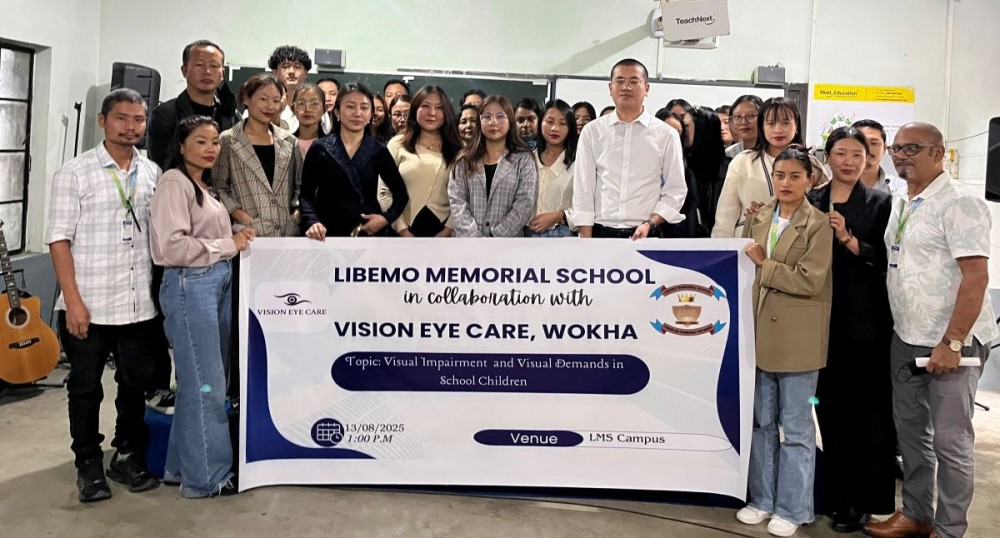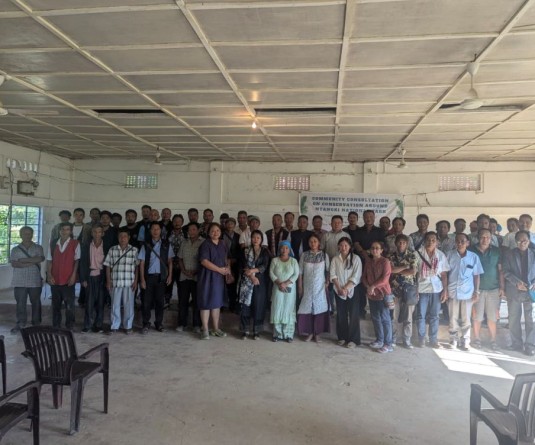Special guest along with Y Porenthung Odyuo, LMS principal and school teachers. (Morung Photo)

Morung Express News
Wokha | August 13
Libemo Memorial School, Wokha, in collaboration with Vision Eye Care, Wokha, organised an awareness programme on “visual impairment and visual demands in school children” at the school campus on August 14.
The special guests were Dr Chuchong Noklang, EAC, and Imtiyenla Chang, EAC, while Y Porenthung Odyuo, Consultant Optometrist, Vision Eye Care, Wokha, was the resource person.
Addressing the gathering, Dr Chuchong Noklang stressed that vision and hearing are vital senses in cognitive and personality development, aiding concentration, participation in activities, and the improvement of social and emotional skills. While hearing impairment is relatively rare among children, she noted that visual impairment is becoming increasingly common, particularly with the rise in screen time due to digital learning, social communication, and entertainment, a trend accelerated by the COVID-19 pandemic.
She cautioned that without proper regulation and monitoring, prolonged screen exposure could lead to long-term complications, and emphasised the importance of early health checks, adopting preventive measures, and promoting a healthy lifestyle to support both education and overall well-being.
Imtiyenla Chang reflected on the changes in lifestyle brought about by technological advancement, noting that these shifts have impacted both the mental and physical health of students over time. She underlined the importance of protecting eyesight as a critical aspect of overall health, urging students and the wider community not to take vision care lightly. She encouraged extending awareness efforts beyond schools to include families, friends, and rural communities, stressing that eye health is a collective responsibility.
In his presentation, Y Porenthung Odyuo drew attention to the alarming global rise in myopia over the last three decades, noting that about 40 percent of children aged 6 to 19 are affected, with Asia recording nearly double that rate.
He cautioned that by 2050, almost half of the world’s population could be myopic, with East and Southeast Asia already reporting prevalence rates of 80 to 90 percent among school-leavers. Citing large-scale screenings in India, he said that myopia is more common among older children, females, private school students, and those in urban areas, with prevalence linked to literacy levels.
He explained the different types of refractive errors myopia, hyperopia, astigmatism, and presbyopia—along with symptoms such as blurred vision, headaches, halos, eye strain, and difficulty focusing. Myopia, he said, can be categorised as low or high, with the latter increasing risks of glaucoma, cataracts, retinal detachment, and myopic degeneration. Causes are multifactorial, including reduced outdoor activity of less than 90 minutes daily, prolonged near-work exceeding three hours after school, and parental history of myopia.
Odyuo also spoke on other conditions such as astigmatism, binocular vision disorders like amblyopia, and colour vision deficiency arising from genetic, injury-related, or environmental causes. He warned that average daily screen time of four to six hours is contributing to earlier onset and faster progression of myopia, pointing to studies that show a rise in prevalence among urban Indian children from 4.44 percent in 1999 to 21.15 percent in 2019. As a positive example, he mentioned Rishi Valley School in Andhra Pradesh, which restricts gadget use and encourages outdoor learning.
He stressed preventive steps such as regular screenings, increased outdoor time, following the 20-20-20 rule, and promoting healthy visual habits. Teachers, he said, play a vital role in identifying early signs students struggling to read the board, squinting, rubbing eyes, or copying from peers and should ensure those with high refractive errors sit in front rows with proper lighting and minimal glare.
Odyuo further underlined how classroom environments impact vision and learning, citing factors like lighting, ventilation, air quality, temperature, and noise levels. He suggested integrating task demand assessments into school screening protocols so that children with mild to moderate impairments can be accommodated in regular classrooms.





